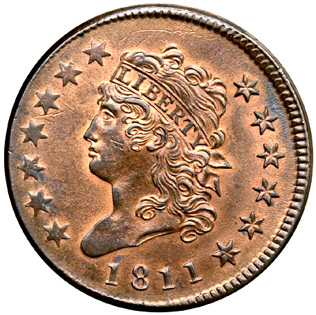Classic Head on:
[Wikipedia]
[Google]
[Amazon]

 The Classic Head was a coin design issued by the
The Classic Head was a coin design issued by the

 The Classic Head was a coin design issued by the
The Classic Head was a coin design issued by the United States Mint
The United States Mint is a bureau of the Department of the Treasury responsible for producing coinage for the United States to conduct its trade and commerce, as well as controlling the movement of bullion. It does not produce paper money; tha ...
in the early 19th century. It was introduced for copper coinage in 1808 by engraver John Reich and later redesigned and improved by Chief Engraver William Kneass.
Dates minted
* (John Reich) Half cents: 1809 to 1836 * (John Reich) Large cents: 1808 until 1815 * (William Kneass) Quarter eagle: 1834 to 1839 * (William Kneass) Half eagle: 1834 to 1837Description
The short-lived Classic Head interpretation ofLiberty
Liberty is the ability to do as one pleases, or a right or immunity enjoyed by prescription or by grant (i.e. privilege). It is a synonym for the word freedom.
In modern politics, liberty is understood as the state of being free within society fr ...
was designed by John Reich for use on the half cent
The half cent was the smallest denomination of United States coin ever minted. It was first minted in 1793 and last minted in 1857. It was minted with five different designs.
History
First authorized by the Coinage Act of 1792 on April 2, 1792, ...
and the large cent
The United States large cent was a coin with a face value of 1/100 of a United States dollar. Its nominal diameter was 1 inch (28.57 mm). The first official mintage of the large cent was in 1793, and its production continued until 1857, whe ...
; however, the design used on the silver and gold coins was developed by William Kneass
William Kneass ( "niece"; September 25, 1780 – August 27, 1840) was the second Chief Engraver of the United States Mint from 1824 until his death in 1840.
Kneass is credited with designing the "Classic Head" motif, which appeared on numerous ...
. The Classic Head depicted Liberty with long, curly hair. The reverse designed by John Reich depicted the coin's denomination and value inside a wreath.
Kneass's design, however, scaled down the design so it would fit on smaller coins and then added a heraldic eagle
The eagle is used in heraldry as a charge, as a supporter, and as a crest. Heraldic eagles can be found throughout world history like in the Achaemenid Empire or in the present Republic of Indonesia. The European post-classical symbolism of the ...
on the reverse, substituting the simple design by John Reich. A similar design on gold coinage kept the name "Classic Head", but only retained the curly hair. The head was completely redesigned by William Kneass, and featured a traditional maiden with a ribbon binding her long, curly hair.
This variety omitted "E pluribus unum
''E pluribus unum'' ( , , ) – Latin for "Out of many, one" (also translated as "One out of many" or "One from many") – is a traditional motto of the United States, appearing on the Great Seal along with ''Annuit cœptis'' (Latin for "he ...
" from the reverse of the coin. In 1840, a smaller head was designed to conform with the appearance of the larger gold coins, therefore making the Classic Head design obsolete. The new Classic Head design was produced from 1834 to 1839.
The Classic Head variety was usually preceded by the Draped Bust design and followed by the Matron Head
The Coronet large cent was a type of large cent issued by the United States Mint at the Philadelphia Mint from 1816 until 1839.
There are two similar designs of the Coronet large cent, the Matron Head and the Braided Hair, the latter with a ...
liberty on copper coinage.
Usage
The design was used for the following coins: *Half cent
The half cent was the smallest denomination of United States coin ever minted. It was first minted in 1793 and last minted in 1857. It was minted with five different designs.
History
First authorized by the Coinage Act of 1792 on April 2, 1792, ...
* Large cent
The United States large cent was a coin with a face value of 1/100 of a United States dollar. Its nominal diameter was 1 inch (28.57 mm). The first official mintage of the large cent was in 1793, and its production continued until 1857, whe ...
* Quarter eagle
The quarter eagle was a gold coin issued by the United States with a value of two hundred and fifty cents, or two dollars and fifty cents. It was given its name in the Coinage Act of 1792, as a derivation from the US ten-dollar eagle coin.
Hist ...
* Half eagle
The half eagle is a United States coin that was produced for circulation from 1795 to 1929 and in commemorative and bullion coins since 1983. Composed almost entirely of gold, its face value of five dollars is half that of the eagle coin. Produ ...
See also
* Classic Head quarter eagleSources
R.S. Yeoman
Richard Sperry Yeoman (born Richard S. Yeo; August 15, 1904 – November 9, 1988) was an American commercial artist and coin collector who marketed coin display boards for Whitman Publishing. Hired by that company in 1932, he redesigned the boar ...
, ''A Guide Book of United States Coins
''A Guide Book of United States Coins (The Official Red Book)'', first compiled by R. S. Yeoman in 1946, is a price guide for coin collectors of coins of the United States dollar, commonly known as the Red Book.
Along with its sister publicatio ...
'' 2009 Edition.
{{Coinage (United States)
1808 introductions
Coins of the United States
Goddess of Liberty on coins